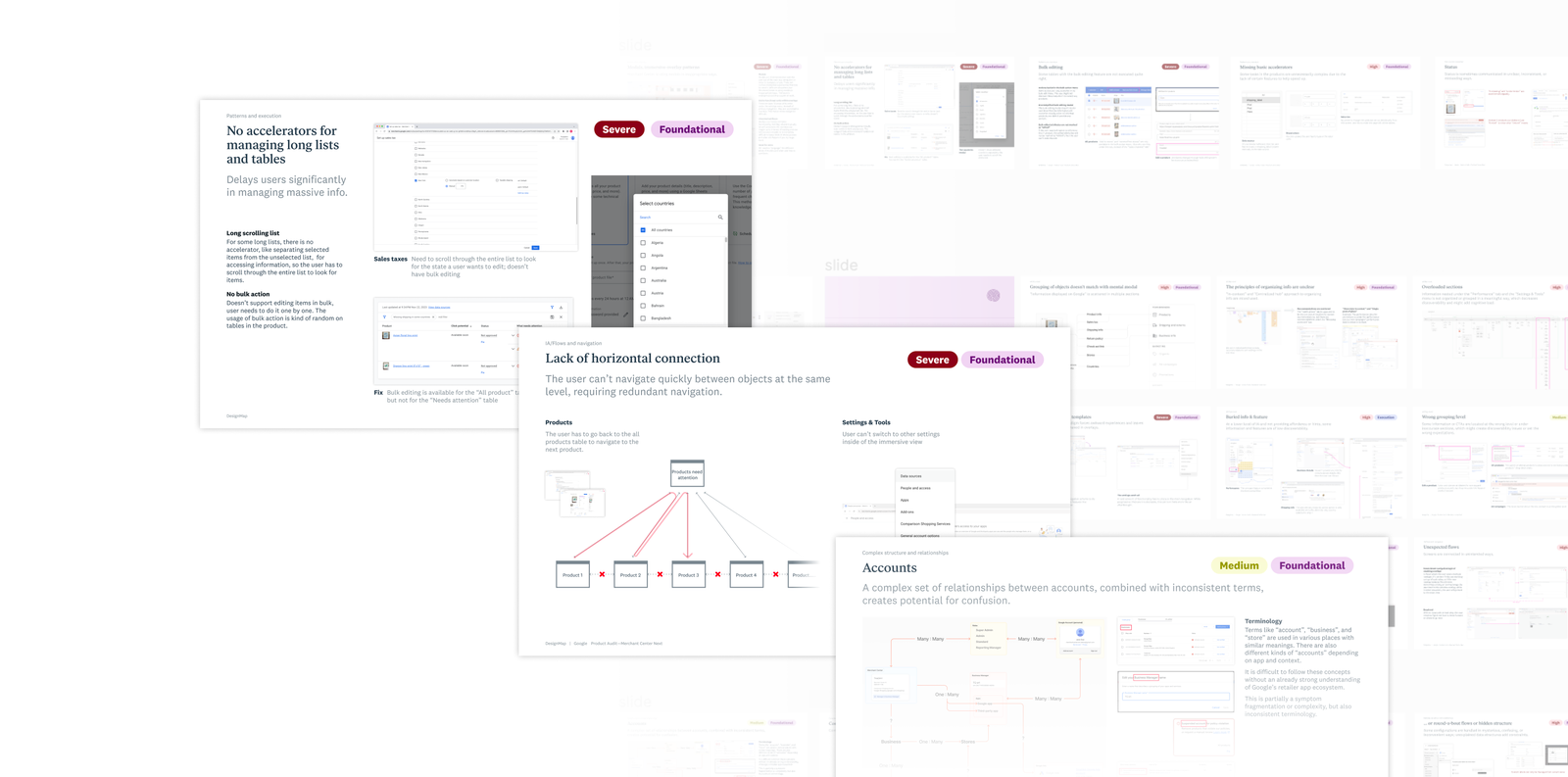DesignMap partners with a lot of different clients that build complex products, often with broad-ranging feature sets. Sometimes, we help them take that broad set of features and requirements and turn them into a new vision or an MVP—but other times, clients need a different kind of engagement that isn’t about starting anew or reimagining their entire platform. Sometimes clients need help getting a clear understanding of where their product stands—either as a planning exercise or as part of an organizational shift to focusing on efficiency and quality.
Maybe one of the following scenarios resonates with you:
- You’re in the middle of a migration to a redesigned platform experience. Teams are rushing to port over legacy features. You need the new experience to land well, but it’s hard to keep track of everything that has changed and what needs more attention.
- Your product has been around for a while. Some original team leads have left and the replacements are scratching their heads, wondering what they just inherited.
- Design is a new muscle for your company, and many features were created with an engineering-driven mindset. Where can design drive impact right away?
- Your company is embarking on a “year of efficiency,” and one of your mandates is to focus on the quality of product experience. However, in order to do that, you need to understand the most severe problem areas.
If any of these sound familiar, it might be time to consider a product audit.
What is a Product Audit?

Imagine your product is like a big ball of tangled yarn. Short-term issues, like usability glitches, and long-term goals, like expanding the user base, are all mixed up. Over time, the product has become more and more complex and every screen is another thread attached to who-knows-what else. You have no idea where to start pulling first.
A product audit is like having a skilled untangler who can carefully unravel your big ball of mess, show you the connections, and identify where things have become knotted up.
Practically speaking, a product audit typically involves design experts walking through your product user-journey by user-journey, screen by screen, and creating a detailed map of the experience. At DesignMap, we use industry-standard heuristics and our experience in enterprise products to identify where the product is falling short. We capture an inventory of patterns and interactions, highlighting inconsistencies and approaches that are working better than others.
Specific deliverables might include:
- Full audit: screen-by-screen flows captured in a single source-of-truth, with detailed notes and critique.
- Application map: identifying every screen/state and mapping them into a clear visual of how they fit into the navigation.
- Pattern refinements: Documentation that identifies/improves the implicit patterns that have shown up in your product. This can also help find and standardize the common interactions that have been reinvented over and over again.
- Solution concepts: Specific recommendations or concepts that can improve problem areas or push the product in new directions—in a way that only fresh eyes can.
- A prioritized “hit list”: a list of major issues and themes, broken down by severity and category—will help you identify what to tackle first and what will require a bigger initiative.
Building Value at Each Step
With a successful audit, each phase and deliverable builds upon each other:
- A deep understanding of the client and user context guides the evaluation; and
- The evaluation inspires the concepts and priorities.

In this way, our product audit is not an academic, one-size-fits-all exercise. It’s tailored to your product's and your organization's needs and challenges.
The end result? Clarity.
Moving Beyond Reactionary Thinking
When things get tough, especially with big products and platforms, it’s easy to get overwhelmed and fall back into reaction mode. It’s impossible to think about the big picture because you’re always putting out fires and bracing for the next big feature implementation. A product audit can help in a few ways:
- Quick Wins for Today: Product audits aren't just about pointing out problems. We hand you a playbook with practical steps for immediate improvements. It's like a quick tune-up for your car – it runs smoother immediately.
- Painting a Picture for Tomorrow: We don't stop at quick fixes. We sketch out concepts and strategies for the long game. This helps bring the product's overall mission back into focus and lets you see “the forest through the trees.”
- Cross-Functional Harmony: Short-term fixes and long-term visions can sometimes feel on different wavelengths. A product audit is a translator, ensuring everyone from design to marketing speaks the same language.
Paving the Way
Across the technology industry, the mandate is pretty clear right now: efficiency, efficiency, efficiency.
Product audits are an oft-overlooked way to understand the platforms you’ve built—not only to fully realize the investment you’ve made researching, designing, and building them in the first place but also to pave the way for exciting new technologies like AI. The more you understand and optimize your product as it exists today, the better positioned you are to integrate and enhance platforms for efficiency and innovation.